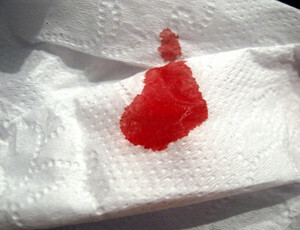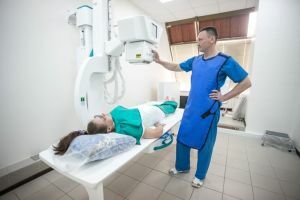 Often a person who is in constant turmoil of his work and personal life, does not notice periodic pain in his stomach.
Often a person who is in constant turmoil of his work and personal life, does not notice periodic pain in his stomach.
The result of such an inattentive relationship subsequently turns out to be an unpleasant symptom in the form of blood on toilet paper every time after defecation.
Only half, who discovered such a nuisance, turns to the proctologist for examination.
The second half simply waits for an independent resolution of the problem, rather than triggering the process of destruction of the body, since blood from the intestine can signal the presence of serious problems, including even cancer of the rectum.
Traces of blood on paper - an excuse for panic attacks?
Traces of blood on toilet paper are not always accompanied by pain. It happens that a person feels well, even perfectly, but that bloody discharge from the intestine does not give rest. Of course, the appearance of blood in the stool is preceded by any reasons, for example, prolonged constipation or diarrhea.
The presented factors lead to the formation of trauma to the intestinal mucosa or the formation of an anal fissure.
Often, blood appears in pregnant women - this symptom is fundamental to contacting a doctor, since scarlet secretions can talk about severe uterine pressure on the intestines.
Causes of bleeding
Before contacting a proctologist for examination, you should carefully look at the color of the blood and track the time or causes of  of its appearance.
of its appearance.
Such actions are necessary for thinning the diagnosis - the specialist will necessarily ask the above questions.
The causes of the appearance of blood from the intestine can be divided into two main criteria, when the pain is felt in the abdomen or anus. This is the main focus for further investigation.
So, after identifying the traces of blood on toilet paper, you need to look more closely at its color and consistency.
These factors may indicate the presence of a particular disease, where it is isolated:
- If the blood is scarlet and mixed with fecal masses, is a direct confirmation of the development of hemorrhoids or the formation of an anal fissure.
- Scarlet blood can remain on toilet paper and with simple "wetting" of without the act of defecation - similar signs can indicate the patient has internal hemorrhoids, a crack and even a cancer of the rectum.
- The traces of scarlet blood and mucus on underwear also indicate the development of hemorrhoids already in the late stages, where the prolapse of the rectum can also be diagnosed.
- Traces of scarlet blood on underwear without additional discharge and without previous aspects for their formation( eg, weight lifting) speak of the development of colon cancer.
- If blood on the underwear manifests itself with mucus and is mixed with feces , most likely, a person develops ulcerative colitis, proctitis, polyps and tumors of the rectum can be noted.
- Often with ischemic colitis or diverticulosis, massive bleeding can occur.
- Often the patient complains to a specialist on about the presence of black feces, which manifests with a certain regularity or permanently - similar signs indicate bleeding of the enlarged esophagus veins, development of cirrhosis of the liver, ulcer and even stomach cancer.
Concomitant symptomatology
As already mentioned above, bleeding is accompanied by pain in the abdomen or anus.
But often there is also a symptom of a slightly different nature, when bleeding can indicate the development of a particular disease:
- mass bleeding may be accompanied by low blood pressure, pale skin and
 with dizziness , such signs may indicate already significant blood loss;
with dizziness , such signs may indicate already significant blood loss; - with hemorrhoids or anal fissure the patient experiences sphincter spasms;
- prolonged diarrhea may indicate the development of an infectious disease balantidiasis;
- cramping abdominal pain often become symptoms of an ulcer, ulcerative colitis, tumor formation in the intestine, and dysentery;
- the presence of an increased body temperature indicates that the patient is progressing a certain infectious disease.
In the presence of concomitant symptoms, the patient must necessarily consult a proctologist for diagnosis, because infectious diseases can be dangerous to others.
What to do with the blood allocation
As already described above, with the allocation of blood from the intestine should visit a proctologist for diagnosis of the disease. During a visit to a specialist, you need to fully and in detail talk about your problem and mention the concomitant symptomatology.
As a rule, a specialist will appoint a patient to undergo a series of examinations, among the most popular and informational methods of diagnosis are:
- Rectoscopy - allows to detect pathologies of the lower part of the intestinal tract, is prescribed for pain in the anus.
- Colonoscopy - is prescribed for abdominal pain, the examination makes it possible to detect almost all changes in the intestine.

- Irrigoscopy - used to diagnose tumors and other lesions, by introducing a special substance and an X-ray.
- Gastroduodenoscopy - used for examination of the stomach and intestines, and sampling of the mucosa for biopsy in order to detect the presence of cancer cells.
- Laparoscopy or a hollow operation - is a cut of the abdominal cavity for collecting fluid, mucous and other components for examination. Also this diagnostic method allows to cure the existing disease in addition. It is used only after detection of suspicious sites.
Blood on toilet paper is a dangerous sign of the development of the disease, which can bring a lot of trouble to the patient or lead to complications. Do not hesitate with the diagnosis, as such delay can lead to death.
